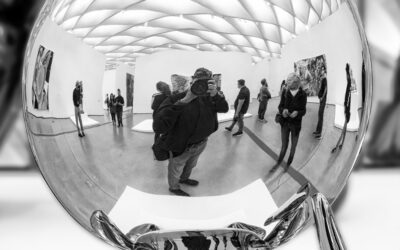With traveling, one of the great challenges is photographing through glass — dealing with reflections and focus.
While traveling, we often run into challenging photographic situations. These situations require photographing through glass. It is a situation where travelers need to learn simple lessons.
Travelers may be in a helicopter or small plane flying over the glaciers of Alaska. A glass wall might protect the pandas at the National Zoological Park. Glass display cases contain a great work of art at the Louvre. Or a striped burrfish is swimming behind the glass of the National Aquarium. You might even want to snap a more mundane photograph of people at work, behind a large, plate glass window.
Great photos can be crafted in each of these situation. But travelers must be prepared to meet the glass challenges: reflection and focus.
Reflections on glass can be a photographer’s bane, but sometimes a friend. One of the biggest problems with reflections is that our brain works so well, sometimes we don’t even notice small ones. But the camera doesn’t miss a thing. When photographing through glass, we must make ourselves aware of these reflections, which sometimes can even be us, or our clothing.
Overcome the automatic focus in many cameras when photographing through glass
When shooting through glass, some cameras have trouble focusing on the subject and attempt to focus on the reflections on the glass. This must be overcome.
In the above photograph of a tailor shop in the Olde City area of Center-City Philadelphia, I wanted to capture the whimsy of the window painting of a tailor at a sewing machine. That required me to focus at the window, and use a midrange aperture (f/8) to create a significant depth of field to keep the shop in focus behind the window. Fortunately, when I came by the shop, the sun was behind the buildings across the street, so their reflection was at a minimum, however, I had to wait for traffic to move past the shop to eliminate its reflection.
Here are some tips to meet the glass challenge:

2. Eliminate reflections. Perhaps the easiest way to eliminate reflections and focus problems is to hold the camera as close to the glass as possible to avoid glare and reflections. If you can, use a rubber lens hood when using a DSLR (digital single-lens reflex) or MILC (Mirrorless Interchangeable Lens Camera), to seal out light. Or, if it’s a point and shoot camera or a smartphone, use your hands at the side of the camera or smartphone to do the same. This is a great way to photograph at an aquarium.
3. Don’t shoot straight on. Sometimes you can’t get very close to the glass, since you want a wider view of the subject behind it. Stand to the side of the subject to minimize the reflections from the light and eliminate your reflection. This will help you whether using a camera or a smartphone.
Photographing through glass needs extra thought and care
4. Special filters can help. Use a circular polarizing filter almost anytime you are shooting through glass — or water, for that matter. Some people suggest the use of a circular polarizer when shooting through the windows of a helicopter or bus. It definitely can help you lessen or eliminate the reflections on the window glass, or helicopter’s Plexiglas, but if you’ve ever worn polarized sunglasses while in these vehicles you already know that it will accentuate the stress marks in the Plexiglas or the spots in the safety glass. Personally, I wouldn’t use one when photographing from a helicopter or bus.
5. Shooting through the window of a moving bus or car? If shooting through a window of a moving bus or a helicopter, there are several things to do. Use a fast shutter speed. That will help you negate the movement of the bus. Consider manually pre-focusing your lens, or if your camera has the capability, use continuous focusing. Set your aperture at midrange to lengthen the depth of field, making up for focusing inaccuracy. If your DSLR or MILC lens has vibration reduction (VR), use it. Use your camera’s image stabilization, if your MILC or point-and-shoot camera has that feature. Get as close to the window as possible without touching it to eliminate glare and reflection from inside the bus.
6. Wear dark clothing. If you know you’re going to be shooting through glass, especially if you’re in a moving vehicle or helicopter, dark clothing minimizes reflections.
Use light and reflection to your advantage when photographing through glass
When shooting with available light, as I did for this photo, there are times when a little reflection can be a good thing. By focusing on the window itself, I was able to capture the neon signs in this bar window, plus the reflection of the sky, and the buildings across the street, to add to the shot’s context and make the photo far more interesting.
Ned Levi is a long time professional photographer with a passion for wildlife and travel photography. You can view some of Ned’s travel and other photos at NSL Photography.
READ ALSO:
What you need to know about 5G C-band deployment and airport safety
VPN — key for travelers’ Internet security
After many years working in corporate America as a chemical engineer, executive and eventually CFO of a multinational manufacturer, Ned founded a tech consulting company and later restarted NSL Photography, his photography business. Before entering the corporate world, Ned worked as a Public Health Engineer for the Philadelphia Department of Public Health. As a well known corporate, travel and wildlife photographer, Ned travels the world writing about travel and photography, as well as running photography workshops, seminars and photowalks. Visit Ned’s Photography Blog and Galleries.






